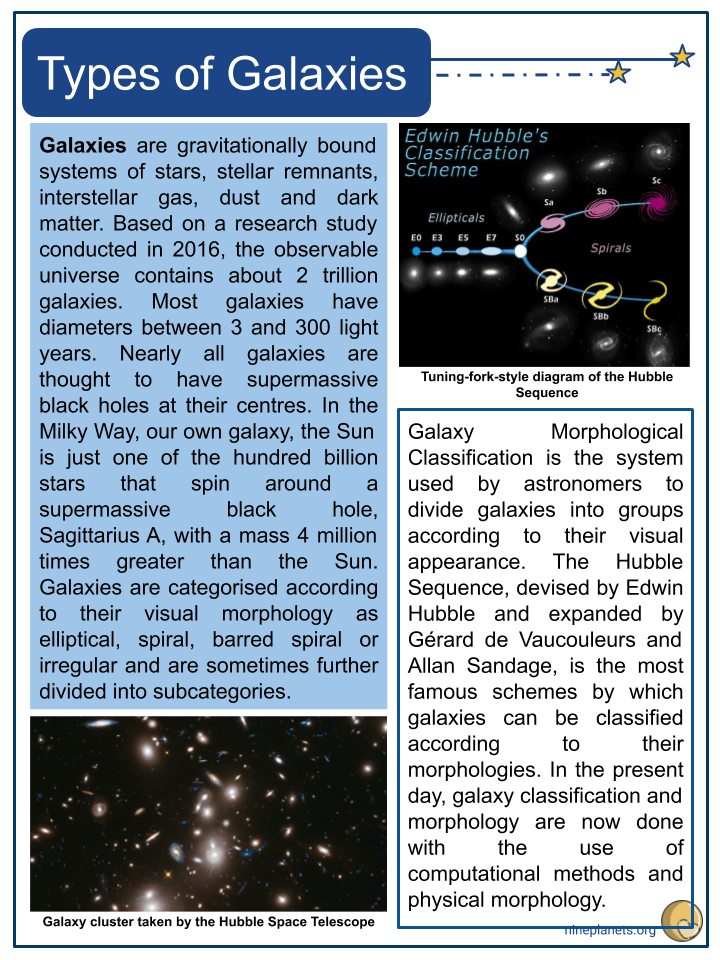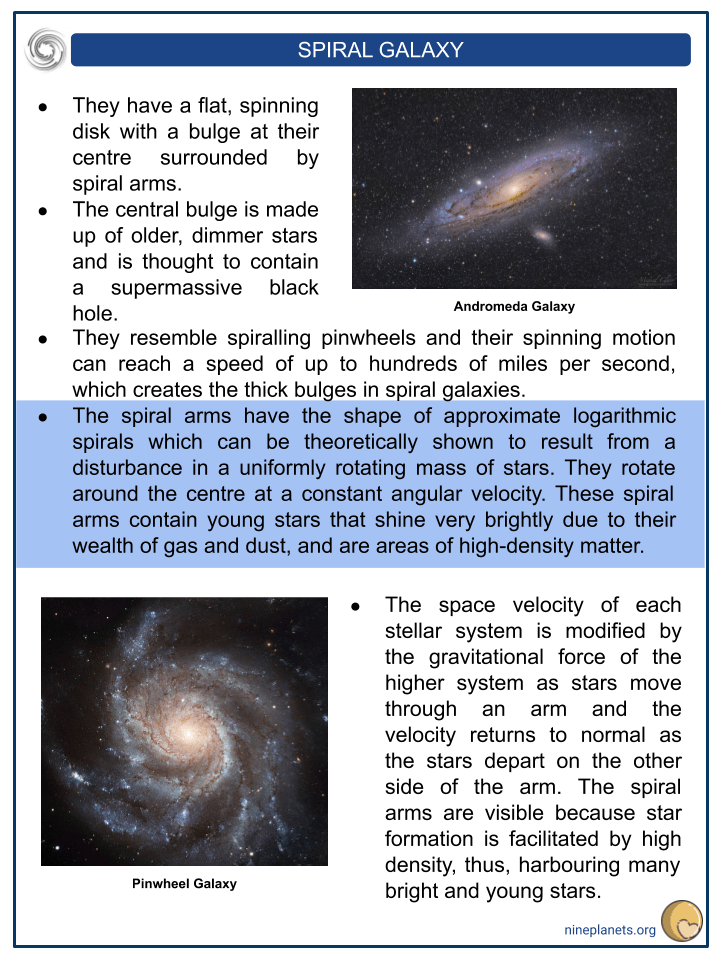Download Types of Galaxies Worksheets
Click the button below to get instant access to these premium worksheets for use in the classroom or at a home.

This worksheet can be edited by Premium members using the free Google Slides online software. Click the Edit button above to get started.
Download free sample
Not ready to purchase a subscription yet? Click here to download a FREE sample of this worksheet pack.
Resource Examples
Click any of the example images below to view a larger version.




Key Facts & Information
- Galaxies are gravitationally bound systems of stars, stellar remnants, interstellar gas, dust and dark matter. Based on a research study conducted in 2016, the observable universe contains about 2 trillion galaxies. Most galaxies have diameters between 3 and 300 light years. Nearly all galaxies are thought to have supermassive black holes at their centres. In the Milky Way, our own galaxy, the Sun is just one of the hundred billion stars that spin around a supermassive black hole, Sagittarius A, with a mass 4 million times greater than the Sun. Galaxies are categorised according to their visual morphology as elliptical, spiral, barred spiral or irregular and are sometimes further divided into subcategories.
- Galaxy Morphological Classification is the system used by astronomers to divide galaxies into groups according to their visual appearance. The Hubble Sequence, devised by Edwin Hubble and expanded by Gérard de Vaucouleurs and Allan Sandage, is the most famous schemes by which galaxies can be classified according to their morphologies. In the present day, galaxy classification and morphology are now done with the use of computational methods and physical morphology.
Spiral Galaxy
- They have a flat, spinning disk with a bulge at their centre surrounded by spiral arms.
- The central bulge is made up of older, dimmer stars and is thought to contain a supermassive black hole.
- They resemble spiralling pinwheels and their spinning motion can reach a speed of up to hundreds of miles per second, which creates the thick bulges in spiral galaxies.
- The spiral arms have the shape of approximate logarithmic spirals which can be theoretically shown to result from a disturbance in a uniformly rotating mass of stars. They rotate around the centre at a constant angular velocity. These spiral arms contain young stars that shine very brightly due to their wealth of gas and dust, and are areas of high-density matter.
- The space velocity of each stellar system is modified by the gravitational force of the higher system as stars move through an arm and the velocity returns to normal as the stars depart on the other side of the arm. The spiral arms are visible because star formation is facilitated by high density, thus, harbouring many bright and young stars.
- Spiral galaxies can be classified based on the tightness of their spiral, the lumpiness of their arms, and the overall size of their central bulge, and these differences are portrayed by the relative amount of gas and dust within a galaxy.
- The most common type of galaxy found throughout the universe that constitutes around 77% of the galaxies observed by man.
- Our neighbour, Andromeda, is an example of a spiral galaxy.
Barred Spiral Galaxies
- Around 2/3s of the spiral galaxies have a bar-like structure and are classified as barred spiral galaxies.
- They share the same features and functions as regular spiral galaxies but their bar of bright stars extends into the disk. Bars are thought to be temporary structures due to a density wave radiating outward from the core or a tidal interaction with the other galaxy.
- The bright bulge contains mostly red stars and has very little activity while both the bar and arms have a lot of activity as a result of gas being channelled into the core along the arms.
- Our own galaxy, the Milky Way, is an example of a barred spiral galaxy.
- Barred Spiral Galaxy Type A (SBa) – features tightly bound arms.
- Barred Spiral Galaxy Type B (SBb) – features both tightly and loosely bound arms.
- Barred Spiral Galaxy Type C (SBc) – features loosely bound arms.
Elliptical Galaxy
- Elliptical galaxies have no bulge or nucleus at the centre, and have an elongated spherical shape. Even without a nucleus, it is still brighter in the centre and less bright toward its edges.
- Theories suggests that the presence of a central black hole is the reason for its great deal of mass.
- Usually composed of many old stars or low mass stars but have little dust and other interstellar matter. These old stars are very dim compared to the spiral galaxies which are very bright. Their light is dominated by the older reddish stars.
- Their stars also orbit the galactic centre but in more random motions and not in a systematic way.
Irregular Galaxies
- There are galaxies that are neither spiral, lenticular or elliptical.
- They are usually small and make up about a quarter of all the galaxies.
- They often have a chaotic appearance due to their lack of distinct shape or form, nuclear bulge, or spiral arms, but are full of gas and dust which makes them great nurseries for new stars as they are also in constant motion.
- They were thought to be once spiral or elliptical galaxies but an uneven external gravitational force caused them to deform.
Other Morphological Types Of Galaxies
- Peculiar Galaxies
- Galactic formations that had tidal interactions with other galaxies that made them develop unusual properties.
- They tend to have more active galactic nuclei indicating the presence of supermassive black holes.
- A lot of starburst of rapid star formation happens due the collision of galaxies.
- Ultra Diffuse Galaxies
- They have extremely low densities which may have the same size as our Milky Way but with only 1% of the visible star count. The lack of star-forming gas causes their lack of luminosity which results in reservoirs of very old stellar populations.
- Three Major Types of Irregular Galaxies
- Irr I – feature some structure but not enough to be in the Hubble Sequence.
- Irr II – do not appear to feature any structure.
- DIrr III – dwarf irregular galaxies that have low metallicity and relatively high levels of gas and are believed to be similar to the earliest galaxies in the universe.
Ring Galaxies
- Galaxies with a ring-like structure of stars and interstellar medium surrounding a bare core.
- They are thought to be formed when a smaller galaxy passes through a core of a spiral galaxy.
- Contain many massive young blue stars that are extremely bright and a central region that has relatively little luminous matter.
- The gravitational disruptions could cause a wave of star formation to move through the larger galaxy.
Lenticular Galaxies
- Galaxies that sit between elliptical and spiral galaxies.
- They resemble lenses which is why they are termed “lenticular”
- They also have a thin rotating disk of stars and a central bulge like spiral galaxies but don’t have spiral arms. And like elliptical galaxies, they have little dust and interstellar matter and seem to form more often in densely populated regions of space.
- Sombrero Galaxy is an example.
Other Types Of Galaxies
- INTERACTING GALAXIES
- Also known as colliding galaxies, they play a key role in galactic evolution.
- Collisions occur when two galaxies have enough relative momentum not to merge as they directly pass through each other.
- The stars in these galaxies will not collide but the gas and dust will interact and may trigger star formation. With insufficient momentum, galaxies gradually merge to form a larger galaxy.
- A collision can distort the shape of the galaxies severely, forming bars, rings or tail-like structures. Mergers can result in significant changes in their morphology. Cannibalism may happen between the galaxies if one is more massive than the other.
- BLAZARS are believed to be active galaxies with a relativistic jet pointing to Earth. A radio galaxy emits radio frequencies from relativistic jets.
- ACTIVE GALAXIES
- A galaxy is considered active if it contains an active galactic nucleus that can emit a significant portion of the total energy output from the galaxy.
- The accretion disc that forms around a supermassive black hole at the core portrays the standard model for an active galactic nucleus.
- STARBURST GALAXIES
- Characterised by dusty concentrations of gas in which stars form at an exceptional rate.
- If starburst continues to happen in the galaxies, they would consume their reserve of gas resulting in a lesser life span.
- These galaxies were common during the early times of the universe and still contribute around 15% of the total star production rate until now.
- LINERS or low-ionisation nuclear emission-line regions have weakly ionised elements that dominate the emission from these galaxies. Approximately 1/3 of the nearby galaxies contains LINER nuclei.
- QUASAR
- Or quasi-stellar radio sources, are the most energetic and distant members of active galactic nuclei.
- They are extremely luminous with 100 times luminosity than the Milky Way. They were first identified as high redshift sources of electromagnetic energy.
- SEYFERT
- One of the two largest groups of active galaxies, along with the quasars.
- They have quasar-like nuclei with very high surface brightness and their host galaxies are clearly detectable.
- Most of them look like normal spiral galaxies but the luminosity of their cores is equal to the luminosity of whole galaxies with the size of the Milky Way.
Did You Know?
- Astronomers classified the other galaxies as “nebulae” before the 20th century, since they looked like fuzzy clouds. In the 1920s, astronomer Edwin Hubble showed that Andromeda “nebula” was a galaxy 2,537 million light years away but still the closest large galaxy to our Milky way. It is bright enough to be visible to the naked eye in the Northern Hemisphere.
- Super-luminous spiral galaxies have a very large upward diameter of 437,000 light years, a mass of 340 billion solar masses that generate a significant amount of ultraviolet and mid-infrared light, and an increased star formation rate around 30 times faster than the Milky Way.
- The formation of massive stars can produce supernova explosions that result in expanding remnants that powerfully interact with the surrounding gas triggering a chain reaction among the stars.
- The oldest and furthest galaxy is GN-z11, an irregular galaxy, with a distance of 32 billion light years and estimated to be formed just around 400 million years after the Big Bang.
- I Zwicky 18 galaxy was one of the youngest galaxies ever discovered and was estimated to be around 500 million years old.
- MACS 2129-1 or zombie galaxy spins twice as fast as the Milky Way and hasn’t made any stars for around 10 billion years.
- Spiral galaxies such as the Milky Way produce new generations of stars with their dense molecular clouds of interstellar hydrogen in their spiral arms.
- The supply of star-forming material is finite and once the available supply of hydrogen is converted into heavier elements, new star formation will come to an end.
- The rarest type of galaxy is the elliptical double-ringed galaxy which is only around 0.1% of the galaxies observed. It is sometimes called a Hoag-type galaxy.
- Since the Big Bag, little cub remained a dormant dwarf galaxy, and might still contain uncharged molecules.
- Giant elliptical galaxies are the largest galaxies which contain more than a trillion stars and are around 2 million light years away. The dwarf elliptical galaxies are the smallest ones.
- The large and small magellanic clouds are examples of irregular galaxies distorted by the gravity of a larger neighbour, our Milky Way.
- The Milky Way is currently in the process of cannibalising the Sagittarius Dwarf Elliptical Galaxy and the Canis Major Dwarf Galaxy.
- A number of galaxies without dark matter were recently discovered that could lead to a whole new type of galaxies.
- The Milky Way was for a long time classified as a spiral galaxy but recent observations reclassified it as a barred type galaxy.
- The Great Attractor is an unknown force that pulls the most galaxies.
- Formation of the Galaxies
- It is theorised that atoms of hydrogen and helium began to form around 300,000 years after the Big Bang, and recombination happened.
- At that time, most hydrogen atoms were neutral, non-ionised and readily absorbed light, and the density fluctuations led to the creation of larger structures.
- The masses of baryonic matter started to condense within dark matter halos and these primordial structures would eventually become the galaxies.